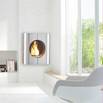- 5 reads

A crackling fire in the fireplace is one of the iconic scenes of comfort and rustic living, but a wood fire also emits an astounding amount of pollution and contaminates into the air. That beautiful, wood fireplace can put as much as 10 grams of particulate pollution into the air for every hour it burns.
EPA-certified wood burning fireplaces and stoves are a little better but 30 homes heating with certified fireplaces and stoves still create as much pollution as 12,000 homes heating with natural gas.
Aside from the environmental impact, the amount of ash and soot in the air can make a warm, inviting indoor fire simply unbearable for people with allergies and unhealthy for everyone else. Discovering what burning wood puts into our indoor air comes as a surprise to most people. A McMaster University chemist, Brian McCarry, has compared the toxic content of smoke from fireplaces and old-fashioned wood stoves to that of diesel exhaust and tobacco smoke.
Considering that most people spend the majority of their lives indoors, indoor air quality is critical to good health. With the winter months fast approaching, people will be spending even more time inside with the dust and other pollutants caused by closed homes and old heating systems. Contaminated indoor air, such as that caused by fireplaces, can lead to many health problems. At the least, it can cause headaches, irritated eyes, congestion, and nausea. Airborne particulates can also cause, or greatly exacerbate, asthma. Most seriously, indoor fireplaces and stoves can cause chronic health problems or even kill. Fireplaces and stoves, especially wood-burning ones, can release large amounts of carbon monoxide and nitrogen dioxide into the air. Both of these gases can cause serious health problems. Carbon monoxide causes fatigue, headache, confusion, dizziness, nausea, and even death. Nitrogen dioxide causes irritation of the eyes and respiratory tissue and if inhaled in large quantities this can cause chronic bronchitis.
One must also consider the environmental effects of burning wood. Trees must be cut down to supply logs. This is usually done in an ad-hoc and unsustainable fashion with little or no thought given to low-impact methods of harvesting timber. For those who don’t live near a forest, there’s an even bigger carbon footprint created by transporting the logs to your home and burning oil or kerosene in a fireplace is little better. A crackling fire may be the emblem of rustic living but it is hardly, “green” or healthy.
For those who want the warmth and comfort of an indoor fireplace without all of the negative health and environmental consequences, there is an option. A number of bio-fuel fireplaces that have recently come on the market provide a warm, “green” fire. As a LEED AP and someone who started a green company that markets and sells “green” furnishings and home goods, I happened upon biofuel fireplaces over four years ago. I have been building relationships and collaborating with the major manufacturers/distributors who are producing both ethanol-burning fireplaces and the biofuel ever since.
Here at Working Wonders, we’re always happy to answer questions from first-time buyers about these wonderful fireplaces. Our knowledgeable staff can tell you more about them and, if you’re interested, help you find the right one for your home or business. In addition to retrofitting an existing fireplace, ethanol fireplaces can be freestanding, hang on the wall like a picture, or be incorporated into pieces of furniture such as coffee tables. You can view examples of this exciting fireplace technology at www.workingwonderus.com. The ethanol fuel burns as cleanly as natural gas but without depleting our natural resources. They have clean, modern styling and come in many sizes and types for both indoor and outdoor use. You can have the aesthetic beauty and warmth of a fireplace this winter while still living healthy and sustainably.
BethAnn Lederer, LEED AP is the founder of Working Wonders, a company that offers a “one-stop” source where design-build professionals and consumers alike can quickly and easily find aesthetically pleasing eco-responsible products, knowledge and services to build out, furnish and accessorize green projects, homes and workplaces. BethAnn speaks and writes about the links that exist between human health and the products we choose to furnish and accessorize our homes and workplaces. Her perspective comes out of a former career in healthcare education, marketing and advocacy.

